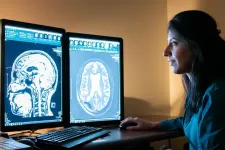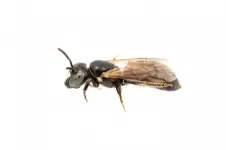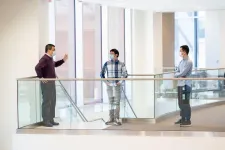(Press-News.org) West Virginia University scientists used MRI scans to show what happens when ultrasound waves target a specific area of Alzheimer's patient's brains. They concluded that this treatment may induce an immunological healing response, a potential breakthrough for a disease that accounts for up to 80% of all dementia cases.
Rashi Mehta, a researcher with the WVU School of Medicine and Rockefeller Neuroscience Institute, led the study that appears in the journal Radiology.
"Focused ultrasound is an innovative technique and new way of approaching brain diseases, including Alzheimer's disease," said Mehta, an associate professor in the Departments of Radiology, Neuroscience and Neuroradiology. "Novel techniques are needed for Alzheimer's disease since traditional approaches have not proven effective."
In 2018, WVU launched a first-of-its-kind clinical trial to explore the use of focused ultrasound to open the blood-brain barrier in early-stage Alzheimer's patients.
"The blood-brain barrier has long presented a challenge in treating the most pressing neurological disorders," said Ali Rezai, the executive chair of RNI and principal investigator of the clinical trial. "The ability to noninvasively and reversibly open the blood-brain barrier in deep brain areas, such as the hippocampus, offers a new potential in developing treatments for Alzheimer's disease."
The ultrasound targeted the hippocampus in particular because it plays a large role in learning and memory.
Mehta used MRI with contrast-enhancement dye to observe the changes that took place in the brains of three early-stage Alzheimer's patients--ages 61, 72 and 73--who underwent the ultrasound treatment.
She observed that the dye moved along the course of draining veins following the procedure.
"This imaging pattern was unexpected and enhances our understanding of brain physiology," she said. "The glymphatic system, which is a fluid-movement and waste-clearance system that's unique to the brain, has been studied in animals, but there is controversy about whether this system truly exists in humans. The imaging pattern that we discuss in the paper offers evidence not only to support that the system does likely exist in humans but that focused ultrasound may modulate fluid movement patterns and immunological responses along this system."
Mehta and her colleagues' analysis of the MRI scans suggests that an immunological healing response may occur around the draining veins following the procedure.
Her research team included Rezai; RNI researchers Jeffrey Carpenter, Marc Haut, Manish Ranjan, Umer Najib, Paul Lockman, Peng Wang and Pierre-Francois D'haese; and Rupal Mehta from the Rush University Alzheimer's Disease Center.
"This observation may be an important clue in understanding the physiological mechanism by which the focused ultrasound procedure modifies brain amyloid levels and might be used to treat patients with Alzheimer's disease and other brain disorders," she said.
Why are amyloid levels important? Unusually high amounts of this protein tend to clump together in the brains of Alzheimer's patients, forming plaques between nerve cells and sabotaging their function. The ongoing clinical trial aims to assess whether focused ultrasound can reduce amyloid plaques in patients with Alzheimer's disease.
This project did not involve any medications. The ultrasound itself was enough to elicit a probable immunological response. In the future, however, the treatment may make it easier to medicate the brain with more precision, even in people who don't have Alzheimer's disease.
"The blood brain barrier limits our ability to deliver drugs and therapeutic agents directly to the brain," Mehta said. "Therefore, opening this barrier in patients would allow focal delivery of medications in select brain regions targeted by the procedure."
The clinical trial--sponsored by INSIGHTEC, the manufacturer of the ultrasound device--continues.
As Mehta and her team enroll more participants, they plan to examine the treatment's long-term effects. They want to know whether it is safe and effective for slowing--or even reversing--the progression of Alzheimer's dementia.
So far, the results are promising. The treatment has not harmed any of the participants who have completed it.
"We are thankful to the patients who have volunteered for this trial," Mehta said. "They are brave to undergo this procedure, which if proven effective may benefit patients with Alzheimer's disease in the future."
Alzheimer's disease is the nation's most common form of dementia, and it's on the rise. The Alzheimer's Association reports that 5.8 million Americans age 65 and older had Alzheimer's dementia in 2020. By 2050, that number could rise to 13.8 million.
The focused ultrasound team at RNI is committed to improving the lives of patients with Alzheimer's disease by pioneering advances using a truly integrated approach and the latest technologies.
INFORMATION:
Research reported in this publication was supported by the National Institute of General Medical Sciences, a division of the National Institutes of Health, under Award Number 5U54GM104942-04. This publication does not necessarily reflect the views of NIGMS or NIH.
Citation
Title: Blood-brain barrier opening with MRI-guided focused ultrasound elicits meningeal venous permeability in humans with early Alzheimer disease
DOI: https://doi.org/10.1148/radiol.2021200643
Link: https://pubs.rsna.org/doi/10.1148/radiol.2021200643
-WVU-
see/02/25/21
New research in mice published today in the journal Scientific Reports strengthens the growing scientific consensus regarding the role of the gut microbiome in neurodegenerative disorders including Alzheimer's disease.
The study, led by researchers at Oregon Health & Science University, found a correlation between the composition of the gut microbiome and the behavioral and cognitive performance of mice carrying genes associated with Alzheimer's. The mice carried the human amyloid precursor protein gene with dominant Alzheimer's mutations generated by scientists in Japan.
The study further suggests a relationship between microbes in the digestive tract ...
A widespread field search for a rare Australian native bee not recorded for almost a century has found it's been there all along - but is probably under increasing pressure to survive.
Only six individual were ever found, with the last published record of this Australian endemic bee species, Pharohylaeus lactiferus (Colletidae: Hylaeinae), from 1923 in Queensland.
"This is concerning because it is the only Australian species in the Pharohylaeus genus and nothing was known of its biology," Flinders University researcher James Dorey says in a new scientific paper in the journal Journal of Hymenoptera Research.
The ...
Immunologists at St. Jude Children's Research Hospital have mapped the previously unknown biological machinery by which the immune system generates T cells that kill bacteria, viruses and tumor cells.
The findings have multiple implications for how the adaptive immune system responds to infections to generate such memory T cells. The experiments revealed mechanisms that inhibit development of the long-lived memory T cells that continually renew to protect the body over time. Blocking these inhibitory mechanisms with pharmacological or genetic approaches could boost protective immunity against infection and cancers.
The researchers also discovered a subtype of memory T cells that they named terminal effector prime cells. Mapping the pathway that controls these cells raises the possibility ...
(Boston)--What if you could improve your heart health and brain function by changing your diet? Boston University School of Medicine researchers have found that by eating more plant-based food such as berries and green leafy vegetables while limiting consumption of foods high in saturated fat and animal products, you can slow down heart failure (HF) and ultimately lower your risk of cognitive decline and dementia.
Heart failure (HF) affects over 6.5 million adults in the U.S. In addition to its detrimental effects on several organ systems, presence of HF is associated with higher risk of cognitive decline and dementia. Similarly, changes in cardiac structure ...
When building a nest, previous experience raising chicks will influence the choices birds make, according to a new study by University of Alberta scientists.
The results show that birds that have successfully raised families stick with tried-and-true methods when building their nests, whereas less successful birds will try something new.
"We found that when presented with a choice between a familiar material, coconut fibre, and a never-before-encountered material, white string, zebra finches who had successfully raised chicks preferred to stick with the same material they had previously used. Birds who failed to raise chicks built nests with equal amounts of familiar and novel material," explained ...
America's stark racial disparities in health care have been exposed by COVID-19, but a new study from Michigan State University suggests that Black individuals are more likely than conservative White people to adhere to public health standards due to disparities.
The study, published in the Journal of Racial and Ethnic Health Disparities, used data from MSU's State of the State Survey that was captured during the initial COVID-19 outbreak from a representative group of 800 adults in Michigan.
"Our findings suggest that although COVID impacts all Michiganders, ...
Fiber-optic cables run underneath nearly all city grids across the United States and provide internet and cable TV to millions, but what if those systems could also provide valuable information related to hazardous events such as earthquakes and flooding? A team of researchers at Penn State have found they can do just that.
The scientists are using fiber-optic distributed acoustic sensing (DAS) technology to turn existing telecommunication infrastructure that is already installed underground into a valuable resource for monitoring ground vibrations.
"We discovered the fibers could pick up a wide variety of signal vibrations, from thunderstorms to human walking steps to music concerts," said Tieyuan Zhu, assistant professor of geophysics at Penn State and principal investigator on ...
American Geophysical Union U.S. Geological Survey Joint ReleaseWASHINGTON--Southern California can now expect to see post-wildfire landslides occurring almost every year, with major events expected roughly every ten years, a new study finds. The results show Californians are now facing a double whammy of increased wildfire and landslide risk caused by climate change-induced shifts in the state's wet and dry seasons, according to researchers who mapped landslide vulnerability in the southern half of the state.
"This is our attempt to get people thinking about where these hazards are going to be before there's even a fire," said Jason Kean, a hydrologist at the U.S. Geological Survey in Denver and lead author ...
HOUSTON - (Feb. 25, 2021) - A new theory by Rice University scientists could boost the growing field of spintronics, devices that depend on the state of an electron as much as the brute electrical force required to push it.
Materials theorist Boris Yakobson and graduate student Sunny Gupta at Rice's Brown School of Engineering describe the mechanism behind Rashba splitting, an effect seen in crystal compounds that can influence their electrons' "up" or "down" spin states, analogous to "on" or "off" in common transistors.
"Spin" is a misnomer, since quantum physics constrains electrons ...
BUFFALO, N.Y. -- Graphene is incredibly strong, lightweight, conductive ... the list of its superlative properties goes on.
It is not, however, magnetic -- a shortcoming that has stunted its usefulness in spintronics, an emerging field that scientists say could eventually rewrite the rules of electronics, leading to more powerful semiconductors, computers and other devices.
Now, an international research team led by the University at Buffalo is reporting an advancement that could help overcome this obstacle.
In a study published today in the journal Physical Review Letters, researchers describe how they paired a magnet with graphene, and induced what they describe as "artificial magnetic texture" in the nonmagnetic wonder material.
"Independent of each ...






